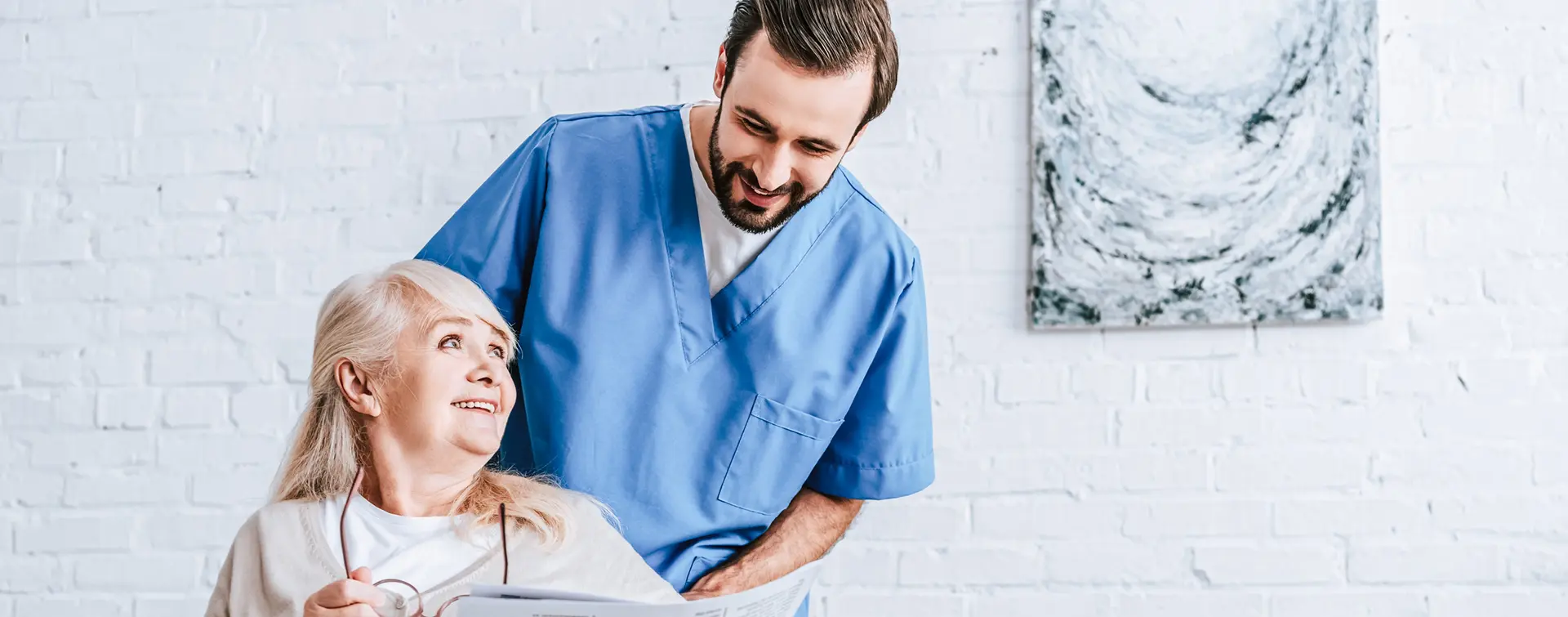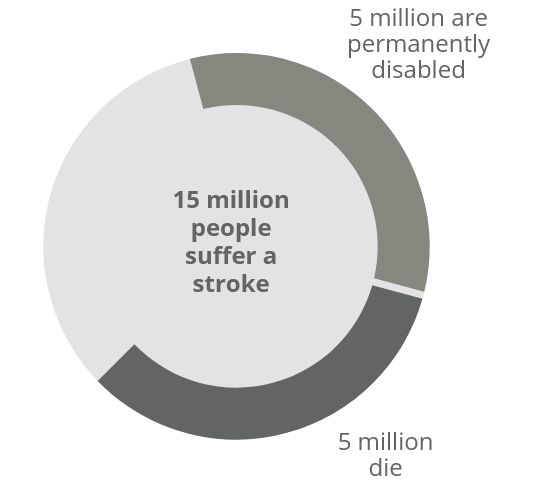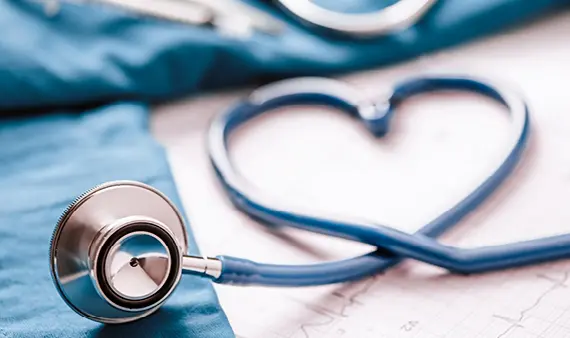
About stroke
Stroke has become the second leading cause of long-term disability and the second cause of death worldwide. Annually, 15.5 million people suffer a stroke. Of these, 5 million die and another 5 million are left permanently disabled, placing a burden on their family and community. A stroke happens when the blood supply to a part of the brain is suddenly interrupted (ischemic stroke) or when a blood vessel in the brain bursts, spilling blood into the spaces surrounding brain cells (haemorrhagic stroke).
In Western societies, about 80% of strokes are caused by focal cerebral ischemia due to arterial occlusion, and the remaining 20% are caused by haemorrhages.
In Western societies, about 80% of strokes are caused by focal cerebral ischemia due to arterial occlusion, and the remaining 20% are caused by haemorrhages.

Shortages of oxygen and nutrients lead to brain cells death. Although stroke is a disorder of the brain, it can affect the entire body and may cause the following problems:
- Trouble with walking, loss of balance or coordination
- Complete paralysis on one side of the body, called hemiplegia
- Hemiparesis is a weakness of one side of the body
- Problems with thinking, awareness, attention, learning, judgment, and memory
- Problems understanding or forming speech
- Difficulty controlling the emotions or may express inappropriate emotions
- Post-stroke depression
- Vascular dementia
Treatment options
Acute stroke therapies include several treatment options depending on the cause of stroke. If a patient suffers from an ischemic stroke caused by a blood clot the healthcare professional may recommend the following options.
Drug Treatment
There is only one approved drug treatment for acute ischemic stroke: tissue plasminogen activator (rtPA) is given via intravenous therapy (IV) and works by dissolving the clot and restoring blood flow to the part of the brain being deprived of blood flow. For safety reasons rtPA is given within 4.5 hours post-stroke.
There is only one approved drug treatment for acute ischemic stroke: tissue plasminogen activator (rtPA) is given via intravenous therapy (IV) and works by dissolving the clot and restoring blood flow to the part of the brain being deprived of blood flow. For safety reasons rtPA is given within 4.5 hours post-stroke.
Mechanical Devices (thrombectomy)
A surgeon inserts the mechanical device via a catheter into the blocked artery. Once inside, the tool traps and removes the clot out of the brain and reopens the blocked blood vessel.
A surgeon inserts the mechanical device via a catheter into the blocked artery. Once inside, the tool traps and removes the clot out of the brain and reopens the blocked blood vessel.
Cerebrolysin®
Cerebrolysin® shall be already used in the acute phase after stroke. It reduces the further death of neuronal tissue and accelerate the healing process in the early stages.
Cerebrolysin® shall be already used in the acute phase after stroke. It reduces the further death of neuronal tissue and accelerate the healing process in the early stages.
In case of haemorrhagic stroke, the first steps are to find the cause of bleeding in the brain and then to control it. Some of the options for treatments include:
- Surgical clips
- Coils inserted in aneurysms
- Surgery to remove the bleeding vessel and
blood that has spilled into the brain - Hemicraniectomy to reduce Intercranial Pressure (ICP)
Stroke rehabilitation guidelines
Post-stroke rehabilitation is essential for individuals to overcome impairments and disabilities. The goals of rehabilitation are to help survivors become as independent as possible and to attain the best possible quality of life.
Cerebrolysin® is an additional evidence-based therapy in acute stroke and in rehabilitation phase. Clinical data confirm benefits in earlier and better motor recovery, increased quality of life and regained independence.
Stroke rehabilitation guidelines of EAN and from top reference countries confirm efficacy of Cerebrolysin®. More than 25% of patients are functionally severely impaired after a stroke and benefit from Cerebrolysin® and early rehabilitation.
Cerebrolysin® is an additional evidence-based therapy in acute stroke and in rehabilitation phase. Clinical data confirm benefits in earlier and better motor recovery, increased quality of life and regained independence.
Stroke rehabilitation guidelines of EAN and from top reference countries confirm efficacy of Cerebrolysin®. More than 25% of patients are functionally severely impaired after a stroke and benefit from Cerebrolysin® and early rehabilitation.

http://www.who.int/cardiovascular_diseases/en/cvd_atlas_15_burden_stroke.pdf
https://www.world-stroke.org/assets/downloads/WSo_Global_Stroke_fact_Sheet.pdf
http://www.ninds.nih.gov/disorders/stroke/stroke.htm
MARKUS, Hugh S. Stroke: causes and clinical features. Medicine, 2004, 32. Jg., Nr. 10, S. 57-61.
Knecht, Stefan, Stefan Hesse, and Peter Oster. “Rehabilitation nach Schlaganfall.” Deutsches Ärzteblatt, Jg 108 (2011).
https://www.world-stroke.org/assets/downloads/WSo_Global_Stroke_fact_Sheet.pdf
http://www.ninds.nih.gov/disorders/stroke/stroke.htm
MARKUS, Hugh S. Stroke: causes and clinical features. Medicine, 2004, 32. Jg., Nr. 10, S. 57-61.
Knecht, Stefan, Stefan Hesse, and Peter Oster. “Rehabilitation nach Schlaganfall.” Deutsches Ärzteblatt, Jg 108 (2011).

